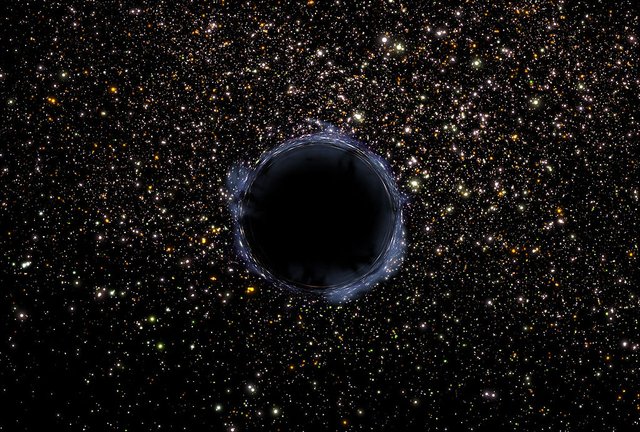Black Holes
Greetings, friends, today I bring you a post about black holes, these mysterious regions of space that hide many mysteries, many still unravelable by science. The idea that there was a body with an extremely dense mass from which even the fastest particles could not escape was proposed by an English geologist whose name was John Michell. As the years have passed, many scientists have made their contributions in terms of black holes, for example, Stephen Hawking is one of the most important contributors.

What is a black hole?
A black hole is considered as a region located in space, which has gravity so strong that even electromagnetic particles (or light) can escape from it. Around it is located a kind of dividing line, called "event horizon" through which light can enter but not exit. It may be thought that black holes are of such color, however, these are invisible because the light that enters them cannot come out, and so they can not reflect it and therefore do not emit any color. But then, if they cannot be seen, how do they detect them? Well, the truth is that there are different methods, for example suppose that a black hole passes or is located between a star and the planet Earth, from here it will be perceived as if that star shines more than usual.
How are they formed?
Black holes are formed thanks to the death of the stars. After the cycle of a "red giant" comes to an end, it causes its gravitational force to be exerted on itself, reaching a point where it collapses, thus generating a mass with little volume, called "white dwarf." After this it is possible that it becomes a neutron star or a black hole, depending on what factors influence (size, life time, among others)
Types of Black Holes
Micro black holes: These holes are of extremely small sizes, it is known that their mass its a way smaller than the Planck mass. It is believed that it is possible to create artificial black micro holes thanks to the Large Hadron Collider (LHC) from the fusion and collisions of sub-atomic particles, which are accelerated at almost the speed of light. It should be noted that the "life" of this type of holes is very short.
Black holes of stellar mass This is formed when a gravitational collapse occurs in a star whose mass exceeds 2.5 times that of the Sun (that becomes a supernova when a great implosion occurs), reason why the volume of its nucleus will be reduced constantly.
Supermassive black holes It is assumed that these black holes have masses greater than billions of times that of the Sun. There are theories that postulate that these types of black holes could be found in the center of most spiral and elliptical galaxies. For example, it is believed that in the center of the Milky Way there is a black hole of this type.

That's all for now, thank you very much if you have come here, I hope you liked the content; you can leave me a vote if so. You can also leave me a comment with your opinion about the post content or give me a suggestion on how I could do better in the next ones :)
References
- http://laflecha.net/archivo/canales/curiosidades/noticias/tipos-de-agujeros-negros
- http://www.astromia.com/astronomia/negroagujero.htm
- https://es.wikipedia.org/wiki/Agujero_negro
- http://www.todoelsistemasolar.com.ar/agujeronegro.htm
(Note that the information of these websites it is on Spanish, I did the traslation for the info that I used on this post)
Hello @atiliog,
It gives us pleasure to inform you that you have been chosen as a featured author by the @robinhoodwhale initiative.
Learn more about the Robinhood Whale here!
If you wish to support this initiative, join the Robinhood Whale voting trail on Streemian. Every vote counts!
We hope to see you continuing to post some great stuff on Steemit!
Good luck!
~RHW~
This post has been ranked within the top 50 most undervalued posts in the first half of Jan 17. We estimate that this post is undervalued by $5.25 as compared to a scenario in which every voter had an equal say.
See the full rankings and details in The Daily Tribune: Jan 17 - Part I. You can also read about some of our methodology, data analysis and technical details in our initial post.
If you are the author and would prefer not to receive these comments, simply reply "Stop" to this comment.
Concerning the microBH:
Their mass is definitely way smaller than the Planck mass. It is instead expected to lie in the TeV range so that they could be produced at the LHC at CERN. As no micro black hole has ben observed so far, this puts constraints on the underlying theory.
Maybe would you mind fixing your post? :D
Done, thanks for your comment!